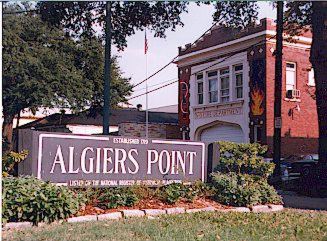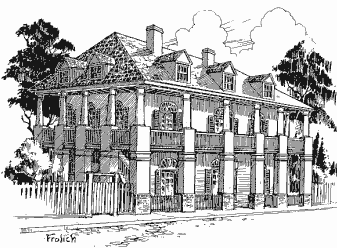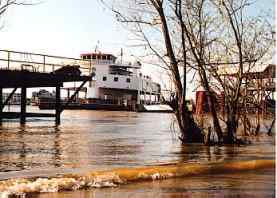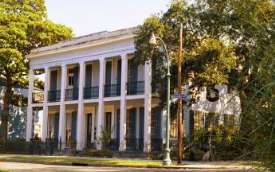New
Orleans Bike Rentals
Discover
New Orleans magical secrets from the seat of a bike.
Whether
you're coming to forget your cares, attend a convention,
experience local culture or to look into attending
a local university, renting a bike is a great way
to get around the Big Easy.
Home
- Why Rent A Bike
- Where
To Ride - Bike
Rental Pricing - Special Deals - Location
& Contact Info
History
of Algiers Point
 Nestled
against the levee of the Mississippi River, a visit
to the neighborhood of Algiers Point is like a walk
back in time.
Nestled
against the levee of the Mississippi River, a visit
to the neighborhood of Algiers Point is like a walk
back in time.  With
churches, schools, small local restaurants, grocery
stores, bars, homes and more all dating to the 19th
century, the pace of life and quiet of The Point stand
in stark contrast to the lights and noise just a ferry
boat ride away in downtown New Orleans & the French
Quarter.
With
churches, schools, small local restaurants, grocery
stores, bars, homes and more all dating to the 19th
century, the pace of life and quiet of The Point stand
in stark contrast to the lights and noise just a ferry
boat ride away in downtown New Orleans & the French
Quarter.
The
name Algiers Point refers to an old navigational term
for the bend in the Mississippi River that bounds
the neighborhood. In 1719, New Orleans' founder Jean
Baptiste Lemoyne, sieur de Bienville, was granted
a large tract of land on the Mississippi's west bank
that included the Point. By 1812, the DuVerje family
had established a plantation on a portion of the tract,
locating their plantation home at the site of the
present day Algiers Courthouse.
 In
the 1820's, the Louisiana legislature granted a license
to a private steamboat company to operate a ferry
between Algiers Point and New orleans. Although this
ferry is now operated by the State of Louisiana, ferryboats
on this route have operated continuously since 1827.
In
the 1820's, the Louisiana legislature granted a license
to a private steamboat company to operate a ferry
between Algiers Point and New orleans. Although this
ferry is now operated by the State of Louisiana, ferryboats
on this route have operated continuously since 1827.
By
the 1840's, the Point's current streetplan was in
place and a vibrant town was in full bloom, with schools,
churches and industry that relied more on the Mississippi
River than the city of New Orleans. An iron foundry,
dry dock, riverfront warehouses, and railhead for
points west all contributed to the community's growing
wealth. In 1869, the DuVerje Plantation home became
the courthouse for Algiers. The following year, Algiers
was annexed by the City of New Orleans.
 By
the 1890's the population of Algiers exceeded 10,000.
Railroading alone occupied 3,000 to 4,000 residents.
By
the 1890's the population of Algiers exceeded 10,000.
Railroading alone occupied 3,000 to 4,000 residents.
In
1895, a terrible fire blazed across Algiers Point,
destroying 250 homes, including the old DuVerje Plantation
(Algiers courthouse). The current courthouse was dedicated
the following year. The first floor housed the police
station. A carriage house in the rear of the courthouse
was the jail (the cell is still there; look for the
iron bars in the window). The courtroom is located
on the 2nd floor and is still in use.
 In
1958, the Greater New Orleans Bridge over the Mississippi
River opened. Since driving over this bridge was significantly
faster than taking the ferryboat, traffic on the Algiers
ferry dropped dramatically. Additionally, families
with cars could access shopping on the Eastbank (and
along the fast growing suburban strip known as the
Westbank Expressway) more easily. These factors led
to a slow decline; however, it also preserved the
housing stock for future generations.
In
1958, the Greater New Orleans Bridge over the Mississippi
River opened. Since driving over this bridge was significantly
faster than taking the ferryboat, traffic on the Algiers
ferry dropped dramatically. Additionally, families
with cars could access shopping on the Eastbank (and
along the fast growing suburban strip known as the
Westbank Expressway) more easily. These factors led
to a slow decline; however, it also preserved the
housing stock for future generations.
In
the 1980's and 1990's, individuals began to rediscover
the beauty of the architecture and lifestyle afforded
by Algiers Point. Homes began to be restored, one
by one. Bed and breakfasts and art galleries opened.
This renaissance resulted in the Algiers Point you
see today - rows of neatly tended shotgun homes as
well as cottages built in the Edwardian, Greek Revival,
Italianate, Louisiana Colonial and Queen Anne styles.
Points of Interest
The Dry Dock Cafe
Besides the Algiers Courthouse and Seger-Rees House, Algiers Point offers a variety of points of interests. As you disembark from the Algiers Ferry, look at the bottom of the "hill" and you'll see the Dry Dock Cafe. This is a good place to wait for the ferry and to people watch as the local "Algerines" at the bar can be colorful and the tables outside are ideal for seeing the action coming and going at the ferry terminal. The Dry Dock has good "comfort food" and live music (on occasion).
Crown & Anchor Pub
Just down Bouny (the side street) from the Dry Dock at the corner of Pelican Avenue is the Crown & Anchor Pub, an English style pub/tavern (complete with darts). This is one of the best neighborhood bars in the city; it also reminds me of the seaman's bars that once peppered the Mississippi waterfront as many catered to sailors from a specific country.
Rosetree Glass Blowing Studio & Gallery
Pedaling down Bouny St, turn left at Opelousas Ave, bicycle a few short blocks and turn left on Vallette. Ride another 2 blocks through the quiet charm of Algiers Point to the corner of Eliza and you'll see an old neighborhood movie theater on the right. You've arrived at Rosetree Studio where beautiful hand blown glass art is crafted, displayed and sold. Open daily, it's worth a peek and the owner/resident artist (Mark) is both friendly and patient.
Seger-Rees House
From Rosetree, continue pedaling up Vallette for 1 block and make a left on Alix. St. You'll soon pass Holy Name of Mary (the neighborhood catholic church). Make a right on Bermuda and you'll pass the House of the Rising Sun bed & breakfast. Turn right a block later onto Delaronde St, go 1 block and, at the corner of Lavergne, the big white house on the right side with the towering oak trees is Seger Rees House. This Italianate style home was built originally as a 2 family residence and is my favorite home in the Point.
Old Point Bar
Continue cycling up Delaronde a few blocks, then turn left onto Olivier St. Ride one block and the street dead ends at Patterson (River Road) and the Old Point Bar. I've spent many a night catching live music at the Old Point. Though not as famous as Tipitina's, House of Blues or some nightclubs on Frenchman, for music lovers, this bar is a New Orleans institution.
Algiers Ferry Landing & Riverfront Bike Trail
Turning left now on Patterson and riding past the Old Point, you'll bike a few blocks past interesting buildings before reaching the Algiers Ferry Landing. Pedal up the small "hill" to get back on the ferry. Better yet, look just beyond the ferry landing and you'll see a paved sidewalk running along the crown of the Mississippi River levee. This is the start of a bike trail that runs for 3 miles to the suburban town of Gretna. Along the way, you'll pass the famous Algiers dry docks, the Algiers waterworks and the original location of Mardi Gras World (the warehouse in which many Mardi Gras floats are stored and built). If the doors are open to the Mardi Gras warehouse, you really need to take a peek inside. It's normally a surreal sight - empty, wildly colored Mardi Gras floats peering out from the warehouse's inner darkness.
After Mardi Gras World, you'll bicycle below the parallel spans of the Crescent City Connection, which tower gracefully above. After a small railroad marshalling yard, you reach McDonoghville, a neighborhood named after former plantation owner John McDonogh, one of the wealthiest men of his time, McDonogh had no direct heirs and donated much of his wealth to create public schools for New Orleans & Baltimore.
Past McDonoghville, the path goes through small chemical plants and tank farms before entering old town Gretna, the seat for the parish (same as a county in other states) of Jefferson. During the week, the activity at the local courthouse, surrounding law offices, etc. has led to a booming lunch rush at adjacent restaurants. Visit off peak and you could have the restaurant all to yourself.
Gretna Ferry Landing
The bike trail ends at the Gretna Ferry Landing and riverfront amphitheater (which serves as one of the stages for the annual GretnaFest). Although tourist maps typically show the Gretna ferry as operational, most of the time, it is closed so plan on biking the 3 miles back to the Algiers ferry to get back to the French Quarter and downtown New Orleans.
New Orleans
Bike Rentals is a service of RideTHISbike.
For more info or to make a reservation, call 504-324-2492
This
page created & maintained by Areafocus,
Inc. All rights reserved. Nestled
against the levee of the Mississippi River, a visit
to the neighborhood of Algiers Point is like a walk
back in time.
Nestled
against the levee of the Mississippi River, a visit
to the neighborhood of Algiers Point is like a walk
back in time.  With
churches, schools, small local restaurants, grocery
stores, bars, homes and more all dating to the 19th
century, the pace of life and quiet of The Point stand
in stark contrast to the lights and noise just a ferry
boat ride away in downtown New Orleans & the French
Quarter.
With
churches, schools, small local restaurants, grocery
stores, bars, homes and more all dating to the 19th
century, the pace of life and quiet of The Point stand
in stark contrast to the lights and noise just a ferry
boat ride away in downtown New Orleans & the French
Quarter. In
the 1820's, the Louisiana legislature granted a license
to a private steamboat company to operate a ferry
between Algiers Point and New orleans. Although this
ferry is now operated by the State of Louisiana, ferryboats
on this route have operated continuously since 1827.
In
the 1820's, the Louisiana legislature granted a license
to a private steamboat company to operate a ferry
between Algiers Point and New orleans. Although this
ferry is now operated by the State of Louisiana, ferryboats
on this route have operated continuously since 1827. By
the 1890's the population of Algiers exceeded 10,000.
Railroading alone occupied 3,000 to 4,000 residents.
By
the 1890's the population of Algiers exceeded 10,000.
Railroading alone occupied 3,000 to 4,000 residents. In
1958, the Greater New Orleans Bridge over the Mississippi
River opened. Since driving over this bridge was significantly
faster than taking the ferryboat, traffic on the Algiers
ferry dropped dramatically. Additionally, families
with cars could access shopping on the Eastbank (and
along the fast growing suburban strip known as the
Westbank Expressway) more easily. These factors led
to a slow decline; however, it also preserved the
housing stock for future generations.
In
1958, the Greater New Orleans Bridge over the Mississippi
River opened. Since driving over this bridge was significantly
faster than taking the ferryboat, traffic on the Algiers
ferry dropped dramatically. Additionally, families
with cars could access shopping on the Eastbank (and
along the fast growing suburban strip known as the
Westbank Expressway) more easily. These factors led
to a slow decline; however, it also preserved the
housing stock for future generations.